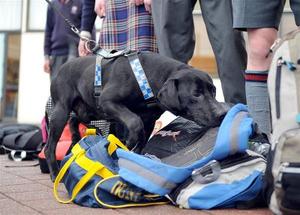Explosives-sniffing dogsHandlers' beliefs affect explosive- and drug-sniffing dog performance
Drug- and explosives-sniffing dog/handler teams’ performance is affected by human handlers’ beliefs, possibly in response to subtle, unintentional handler cues; a new study found that detection-dog/handler teams erroneously “alerted,” or identified a scent, when there was no scent present more than 200 times — particularly when the handler believed that there was scent present

Murphy at work // Source: wxerfm.com
Drug- and explosives-sniffing dog/handler teams’ performance is affected by human handlers’ beliefs, possibly in response to subtle, unintentional handler cues, a study by researchers at UC Davis has found.
“These might be as important — or even more important — than the sensitivity of a dog’s nose.”
To evaluate the effects of handler beliefs and expectations on detection-dog performance, the researchers recruited eighteen handler-detection dog teams from law-enforcement agencies. All of the teams were certified by an agency for either drug detection, explosives detection or both drug and explosives detection.
The dogs all were trained to either alert passively at the location of a scent by sitting or laying down; alert actively by barking; or by doing both. The teams included fourteen male dogs and four female dogs, including Labrador retrievers, Belgian Malinois, German Shepherd dogs, and Dutch Shepherd dogs. The dogs’ level of experience ranged from two to seven years. Their human partners had as many as 18 years of dog-handling experience.
The setting for the study was a church — selected because it was unlikely to have contained either explosives or drugs in the past — where neither the dogs nor the handlers had been before. The researchers created four separate rooms for the dogs to examine or “clear.”
The handlers were told that there might be up to three of their target scents in each room, and that there would be a piece of red construction paper in two of the rooms that identified the location of the target scent. There were, however, no target scents — explosives or drugs — placed in any of the rooms.
Each room represented a different experimental condition or scenario:
- There was one room where the experimenter did nothing — she walked in and walked out;
- In one room she had taped a piece of red construction paper to a
